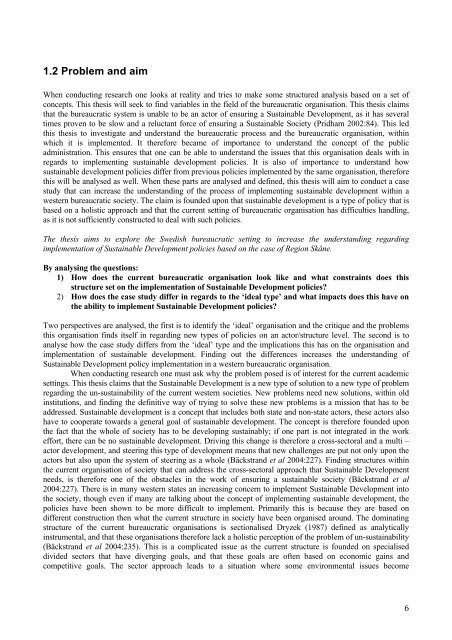From 'grey to green'- investigating the capabilities of the ... - lumes
From 'grey to green'- investigating the capabilities of the ... - lumes
From 'grey to green'- investigating the capabilities of the ... - lumes
You also want an ePaper? Increase the reach of your titles
YUMPU automatically turns print PDFs into web optimized ePapers that Google loves.
1.2 Problem and aimWhen conducting research one looks at reality and tries <strong>to</strong> make some structured analysis based on a set <strong>of</strong>concepts. This <strong>the</strong>sis will seek <strong>to</strong> find variables in <strong>the</strong> field <strong>of</strong> <strong>the</strong> bureaucratic organisation. This <strong>the</strong>sis claimsthat <strong>the</strong> bureaucratic system is unable <strong>to</strong> be an ac<strong>to</strong>r <strong>of</strong> ensuring a Sustainable Development, as it has severaltimes proven <strong>to</strong> be slow and a reluctant force <strong>of</strong> ensuring a Sustainable Society (Pridham 2002:84). This ledthis <strong>the</strong>sis <strong>to</strong> investigate and understand <strong>the</strong> bureaucratic process and <strong>the</strong> bureaucratic organisation, withinwhich it is implemented. It <strong>the</strong>refore became <strong>of</strong> importance <strong>to</strong> understand <strong>the</strong> concept <strong>of</strong> <strong>the</strong> publicadministration. This ensures that one can be able <strong>to</strong> understand <strong>the</strong> issues that this organisation deals with inregards <strong>to</strong> implementing sustainable development policies. It is also <strong>of</strong> importance <strong>to</strong> understand howsustainable development policies differ from previous policies implemented by <strong>the</strong> same organisation, <strong>the</strong>reforethis will be analysed as well. When <strong>the</strong>se parts are analysed and defined, this <strong>the</strong>sis will aim <strong>to</strong> conduct a casestudy that can increase <strong>the</strong> understanding <strong>of</strong> <strong>the</strong> process <strong>of</strong> implementing sustainable development within awestern bureaucratic society. The claim is founded upon that sustainable development is a type <strong>of</strong> policy that isbased on a holistic approach and that <strong>the</strong> current setting <strong>of</strong> bureaucratic organisation has difficulties handling,as it is not sufficiently constructed <strong>to</strong> deal with such policies.The <strong>the</strong>sis aims <strong>to</strong> explore <strong>the</strong> Swedish bureaucratic setting <strong>to</strong> increase <strong>the</strong> understanding regardingimplementation <strong>of</strong> Sustainable Development policies based on <strong>the</strong> case <strong>of</strong> Region Skåne.By analysing <strong>the</strong> questions:1) How does <strong>the</strong> current bureaucratic organisation look like and what constraints does thisstructure set on <strong>the</strong> implementation <strong>of</strong> Sustainable Development policies?2) How does <strong>the</strong> case study differ in regards <strong>to</strong> <strong>the</strong> ‘ideal type’ and what impacts does this have on<strong>the</strong> ability <strong>to</strong> implement Sustainable Development policies?Two perspectives are analysed, <strong>the</strong> first is <strong>to</strong> identify <strong>the</strong> ‘ideal’ organisation and <strong>the</strong> critique and <strong>the</strong> problemsthis organisation finds itself in regarding new types <strong>of</strong> policies on an ac<strong>to</strong>r/structure level. The second is <strong>to</strong>analyse how <strong>the</strong> case study differs from <strong>the</strong> ‘ideal’ type and <strong>the</strong> implications this has on <strong>the</strong> organisation andimplementation <strong>of</strong> sustainable development. Finding out <strong>the</strong> differences increases <strong>the</strong> understanding <strong>of</strong>Sustainable Development policy implementation in a western bureaucratic organisation.When conducting research one must ask why <strong>the</strong> problem posed is <strong>of</strong> interest for <strong>the</strong> current academicsettings. This <strong>the</strong>sis claims that <strong>the</strong> Sustainable Development is a new type <strong>of</strong> solution <strong>to</strong> a new type <strong>of</strong> problemregarding <strong>the</strong> un-sustainability <strong>of</strong> <strong>the</strong> current western societies. New problems need new solutions, within oldinstitutions, and finding <strong>the</strong> definitive way <strong>of</strong> trying <strong>to</strong> solve <strong>the</strong>se new problems is a mission that has <strong>to</strong> beaddressed. Sustainable development is a concept that includes both state and non-state ac<strong>to</strong>rs, <strong>the</strong>se ac<strong>to</strong>rs alsohave <strong>to</strong> cooperate <strong>to</strong>wards a general goal <strong>of</strong> sustainable development. The concept is <strong>the</strong>refore founded upon<strong>the</strong> fact that <strong>the</strong> whole <strong>of</strong> society has <strong>to</strong> be developing sustainably; if one part is not integrated in <strong>the</strong> workeffort, <strong>the</strong>re can be no sustainable development. Driving this change is <strong>the</strong>refore a cross-sec<strong>to</strong>ral and a multi –ac<strong>to</strong>r development, and steering this type <strong>of</strong> development means that new challenges are put not only upon <strong>the</strong>ac<strong>to</strong>rs but also upon <strong>the</strong> system <strong>of</strong> steering as a whole (Bäckstrand et al 2004:227). Finding structures within<strong>the</strong> current organisation <strong>of</strong> society that can address <strong>the</strong> cross-sec<strong>to</strong>ral approach that Sustainable Developmentneeds, is <strong>the</strong>refore one <strong>of</strong> <strong>the</strong> obstacles in <strong>the</strong> work <strong>of</strong> ensuring a sustainable society (Bäckstrand et al2004:227). There is in many western states an increasing concern <strong>to</strong> implement Sustainable Development in<strong>to</strong><strong>the</strong> society, though even if many are talking about <strong>the</strong> concept <strong>of</strong> implementing sustainable development, <strong>the</strong>policies have been shown <strong>to</strong> be more difficult <strong>to</strong> implement. Primarily this is because <strong>the</strong>y are based ondifferent construction <strong>the</strong>n what <strong>the</strong> current structure in society have been organised around. The dominatingstructure <strong>of</strong> <strong>the</strong> current bureaucratic organisations is sectionalised Dryzek (1987) defined as analyticallyinstrumental, and that <strong>the</strong>se organisations <strong>the</strong>refore lack a holistic perception <strong>of</strong> <strong>the</strong> problem <strong>of</strong> un-sustainability(Bäckstrand et al 2004:235). This is a complicated issue as <strong>the</strong> current structure is founded on specialiseddivided sec<strong>to</strong>rs that have diverging goals, and that <strong>the</strong>se goals are <strong>of</strong>ten based on economic gains andcompetitive goals. The sec<strong>to</strong>r approach leads <strong>to</strong> a situation where some environmental issues become6
















